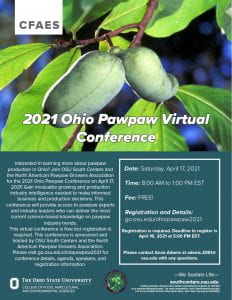
Uncategorized
Women Raising Children on Farms

Women raising children on farms in Ohio, Vermont, and Wisconsin wanted! Researchers are looking for women primary caregivers of children under 18 to participate in an on-line small group discussion and a short survey about how they are juggle children and work. $50 is available as a thank you for your time. For questions, contact Florence Becot with questions at 715-389-9379 or becot.florence@marshfieldresearch.org To sign up to participate, visit this link: https://redcap.link/WomenRaisingChildrenOnFarms
2022 Small Farm Conference Registration
This link will take you to registration details https://go.osu.edu/osufarmconference2022


Small Ruminant AI Day in Licking County (August 21, 2021)
Dean Kreager, OSU Extension Educator ANR, Licking County
Artificial Insemination (AI) results from a multi-breeder insemination day in Licking County.

(Image Source: K Bar K Farm)
The Licking County Sheep Improvement Association has been working with OSU Extension to provide the opportunity for multiple breeders to bring sheep to one location for artificial insemination. The August 2020 date marked the 3rd year of this event. Insemination of 104 sheep occurred during the 2020 event and included both fresh and frozen semen.
Hay Barn Fires are a Real Hazard
 Hay fires are caused when bacteria in wet hay create so much heat that the hay spontaneously combusts in the presence of oxygen. At over 20% moisture mesophilic bacteria release heat-causing temperature to rise between 130°F to 140ºF with temperature staying high for up to 40 days. As temperatures rise, thermophilic bacteria can take off in your hay and raise temperature into the fire danger zone of over 175°F. Continue reading
Hay fires are caused when bacteria in wet hay create so much heat that the hay spontaneously combusts in the presence of oxygen. At over 20% moisture mesophilic bacteria release heat-causing temperature to rise between 130°F to 140ºF with temperature staying high for up to 40 days. As temperatures rise, thermophilic bacteria can take off in your hay and raise temperature into the fire danger zone of over 175°F. Continue reading
Knox County Hazardous Waste Disposal
NOW SCHEDULING APPOINTMENTS
Knox County residents can now schedule appointments to properly dispose of hazardous waste by calling 740-393-4600. Appointments are available the second and fourth Wednesdays of each month beginning in May and running through September. Appointments are still available next week, May 12th.
NOW IS THE TIME TO FINE TUNE YOUR SPRAYER
This article was submitted by Dr. Erdal Ozkan
Dept. of Food, Agriculture and Biological Engineering
Pesticides need to be applied accurately and uniformly. Too little pesticide results in poor pest control and reduced yields, while too much injures the crop, wastes chemicals and money, and increases the risk of polluting the environment. Achieving satisfactory results from pesticides depends heavily on five major factors:
- Positive identification of the pest.
- Choosing the least persistent and lowest toxicity pesticide that will work.
- Selecting the right equipment, particularly the right type and size of nozzle for the job.
- Applying pesticides accurately at the right time.
- Calibrating and maintaining equipment to make sure the amount recommended on the chemical label is applied.
Artificial Insemination Day
Ohio Pawpaw Virtual Conference
Newborn Lamb Care Management
Jeffery Held, Professor Emeritus of Animal Science, South Dakota State University
(Previously published online with South Dakota State University Extension: December 19, 2018)
Proper  newborn lamb care is a critical component of flock profitability. In the U.S. lamb mortality from all causes is approximately 20% with more than 80% of those losses occurring in the first two-weeks following lambing. Yet a solid lamb care management plan coupled with a few key tools in the lambing barn can sharply improve the number of lambs reared per-ewe. Generally, the top causes for newborn lamb losses are starvation, hypothermia (cold stress), respiratory disease, and scours followed by injury. Theoretically, these categories each stand alone, however the reality is often two-or-three of these occur simultaneously. Producers that develop a lambing time-management plan to incorporate appropriate lambing tools and gain key skills on newborn lamb care will benefit from less labor input and expense with a greater number of lambs weaned.
newborn lamb care is a critical component of flock profitability. In the U.S. lamb mortality from all causes is approximately 20% with more than 80% of those losses occurring in the first two-weeks following lambing. Yet a solid lamb care management plan coupled with a few key tools in the lambing barn can sharply improve the number of lambs reared per-ewe. Generally, the top causes for newborn lamb losses are starvation, hypothermia (cold stress), respiratory disease, and scours followed by injury. Theoretically, these categories each stand alone, however the reality is often two-or-three of these occur simultaneously. Producers that develop a lambing time-management plan to incorporate appropriate lambing tools and gain key skills on newborn lamb care will benefit from less labor input and expense with a greater number of lambs weaned.



